Vintage consoles humming alongside rainbow-bright neon, thumping surround sound, and cabinets begging for a high-score run—an arcade room can be so much more than a nostalgia nook. From lighting tricks that deepen immersion to space-saving furniture that keeps joysticks within reach, today’s best ideas blend retro charm with 2025-grade tech and thoughtful design. Below you’ll find twenty stand-alone concepts—each roughly a hundred words—that show how to shape an arcade room that feels purposeful, welcoming, and endlessly replayable. Dive in, cherry-pick what fits your square footage, and let the quarters roll.
1. Retro-Cabinet Arcade Room Corner
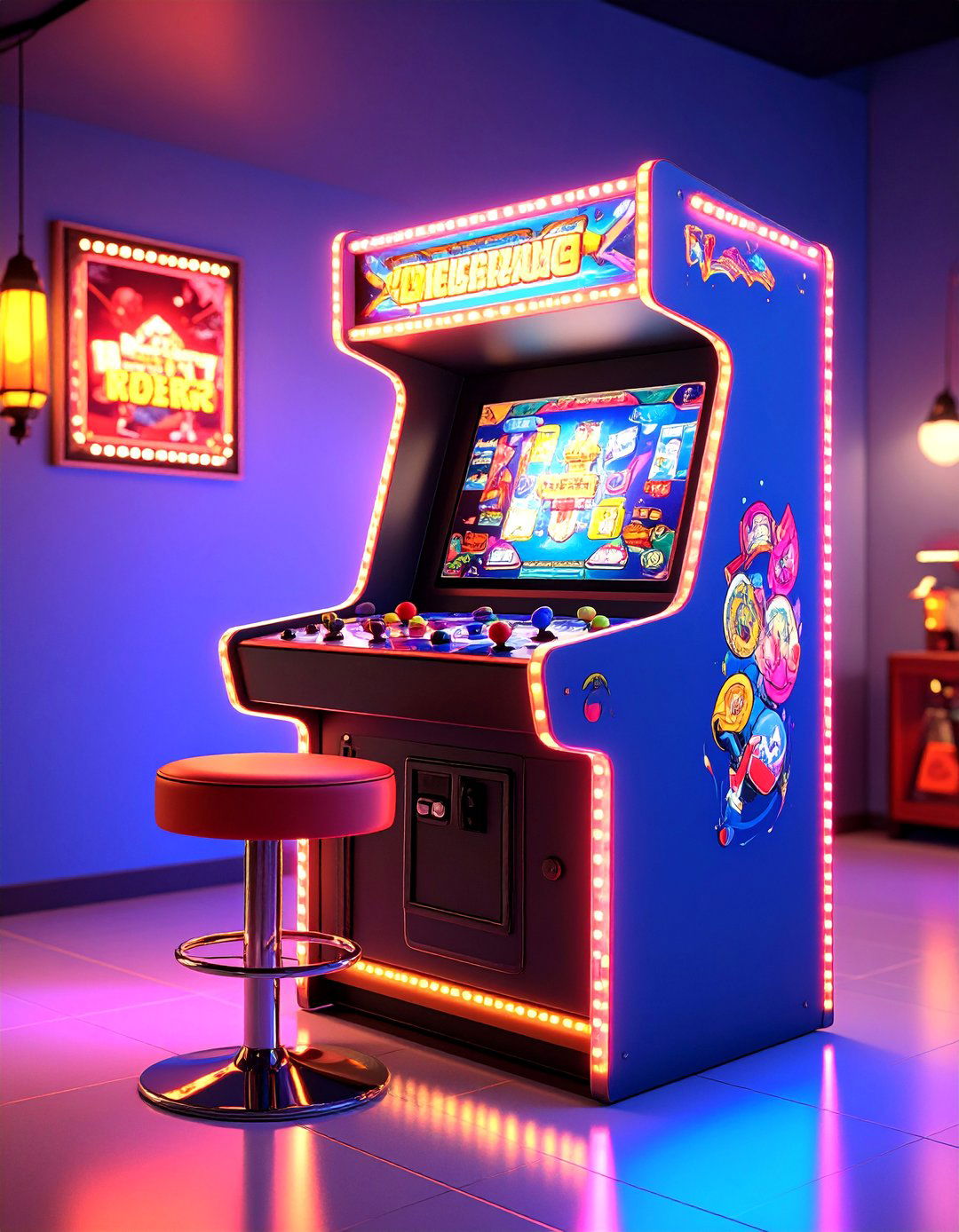
Few upgrades shout “arcade room” louder than a dedicated multicade cabinet, and the latest models cram hundreds of classics into a single upright footprint. Position the cabinet diagonally in a corner so artwork on the side panels becomes wall art, then flank it with low-profile LED rope trim to spotlight its marquee. A stool on casters lets guests hop off quickly during multiplayer hand-offs, and mounting a small shelf above the screen provides space for cartridges or handhelds you still treasure. Finish with a framed flyer from the original game to create instant storytelling on the wall.
2. LED Immersion Arcade Room Lighting

Wrapping the room in addressable RGB strips lets you change the vibe from ‘80s neon to synthwave dusk with a voice command. Run one strip behind crown molding for gentle ceiling wash, another under the cabinet toe-kicks for a floating illusion, and add diffused backlighting behind wall-mounted monitors to reduce eye strain during marathon sessions. Map the lights to music-reactive scenes so a boss fight triggers pulsing reds, or tie them into smart plugs that shut off when the last console powers down, trimming energy use without breaking immersion.
3. Soundproofed Arcade Room Sanctuary
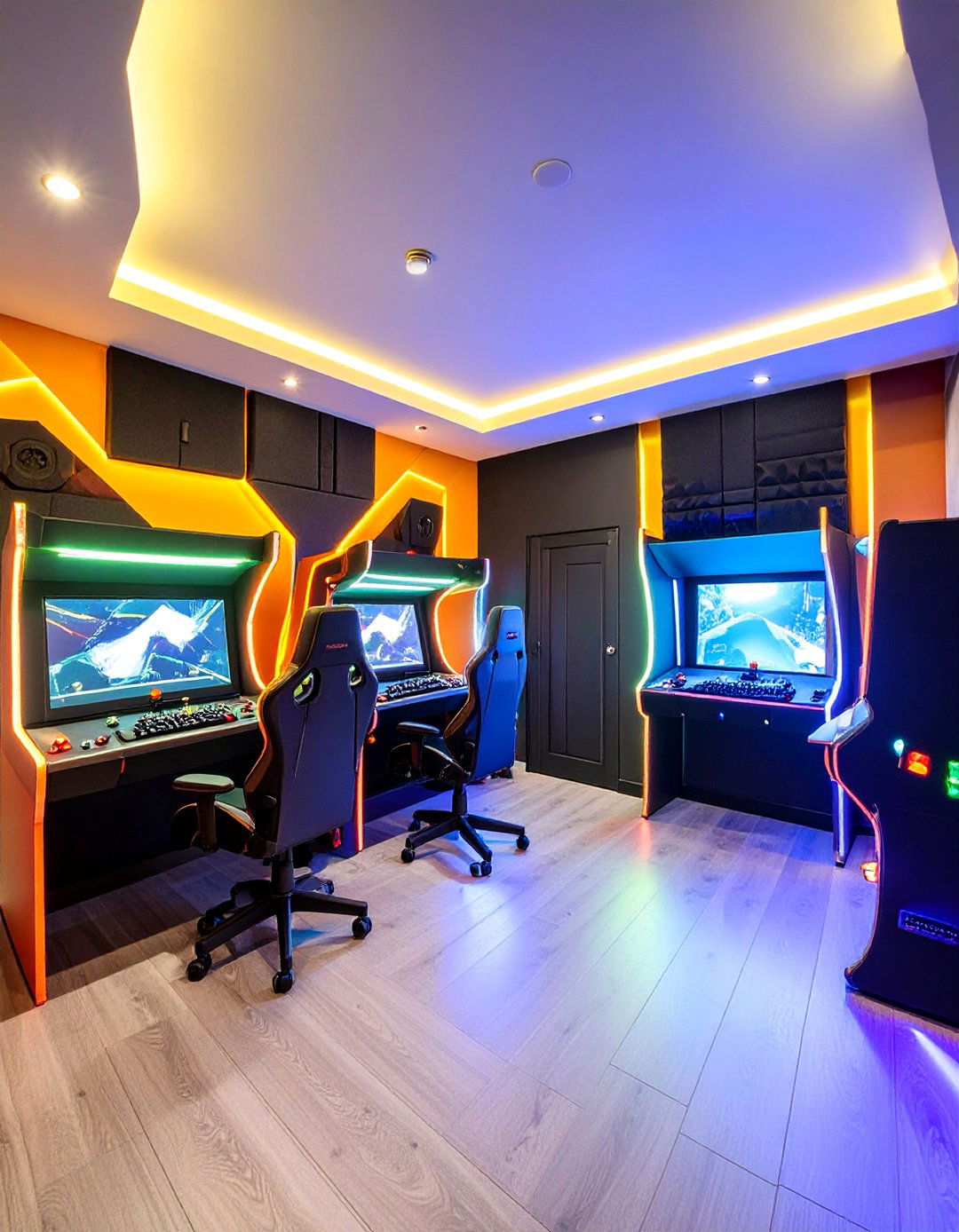
Nothing ruins a late-night run like the thump of a subwoofer rattling upstairs bedrooms. Double-layering drywall with acoustic glue blocks much of that vibration. Tack on foam bass traps in upper corners and hang fabric-wrapped acoustic panels behind cabinets—bonus points if you print pixel art on the fabric for décor with purpose. If budget allows, a solid-core door with weather stripping seals leaks, while rugging high-traffic zones helps absorb footfall. Aim for a room that feels alive inside yet barely whispers beyond the threshold.
4. Flexible Seating Arcade Room Lounge
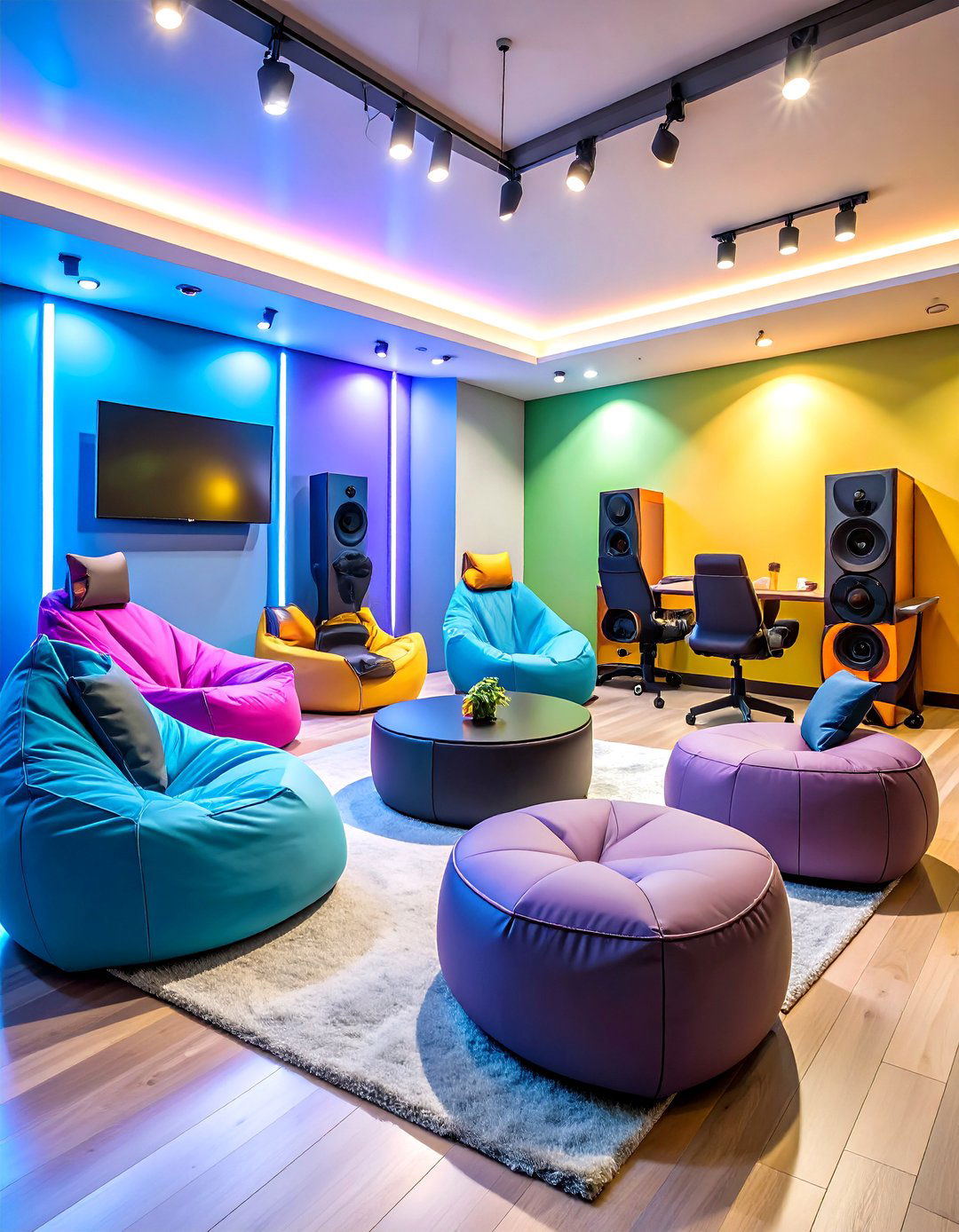
Beanbags and modular gaming chairs invite players to sprawl during couch-co-op nights, then stack neatly when you need floor space for rhythm games. Opt for covers in wipe-clean fabric so spilled soda isn’t a high-score tragedy, and choose at least one rocker-style chair with built-in speakers for solo immersion. Place locking casters on lighter pieces to glide them aside in seconds, and stash a collapsible ottoman that doubles as cartridge storage. With versatile seating, the room pivots from competitive arcade to laid-back movie lounge without a heavy lift.
5. Neon-Sign Arcade Room Statement Wall
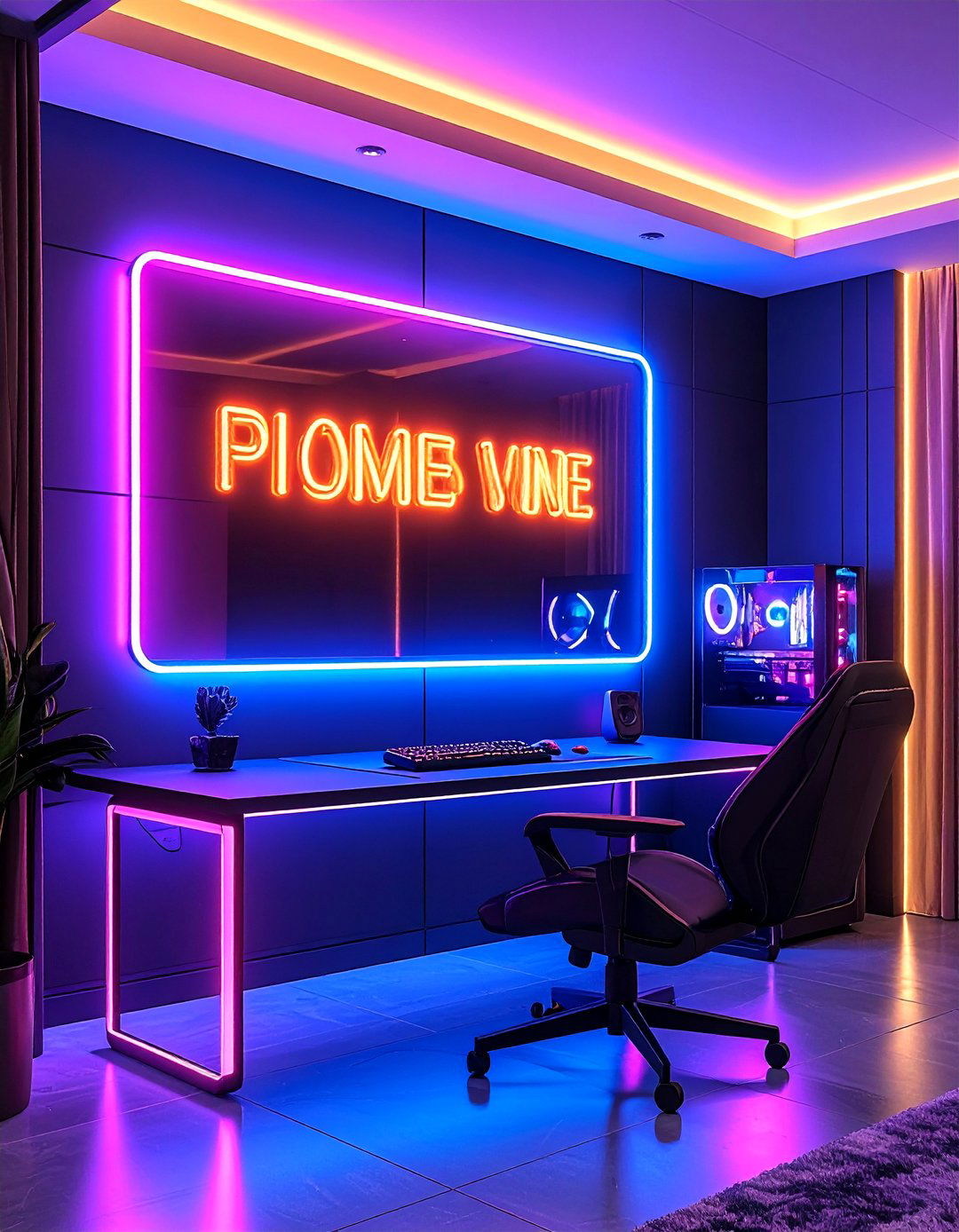
A custom LED or glass neon sign—think “Press Start” or a favorite character silhouette—acts as both artwork and ambient light. Mount it on a matte-black accent wall so colors pop, and route the low-voltage cord through paintable cable channels for a clean look. Dimmers or smart plugs keep glare off the screen, while a mirror on the opposite wall doubles the glow. The result is an Instagram-ready focal point that sparks nostalgia before anyone even grabs a joystick.
6. Tournament-Ready Arcade Room Hub
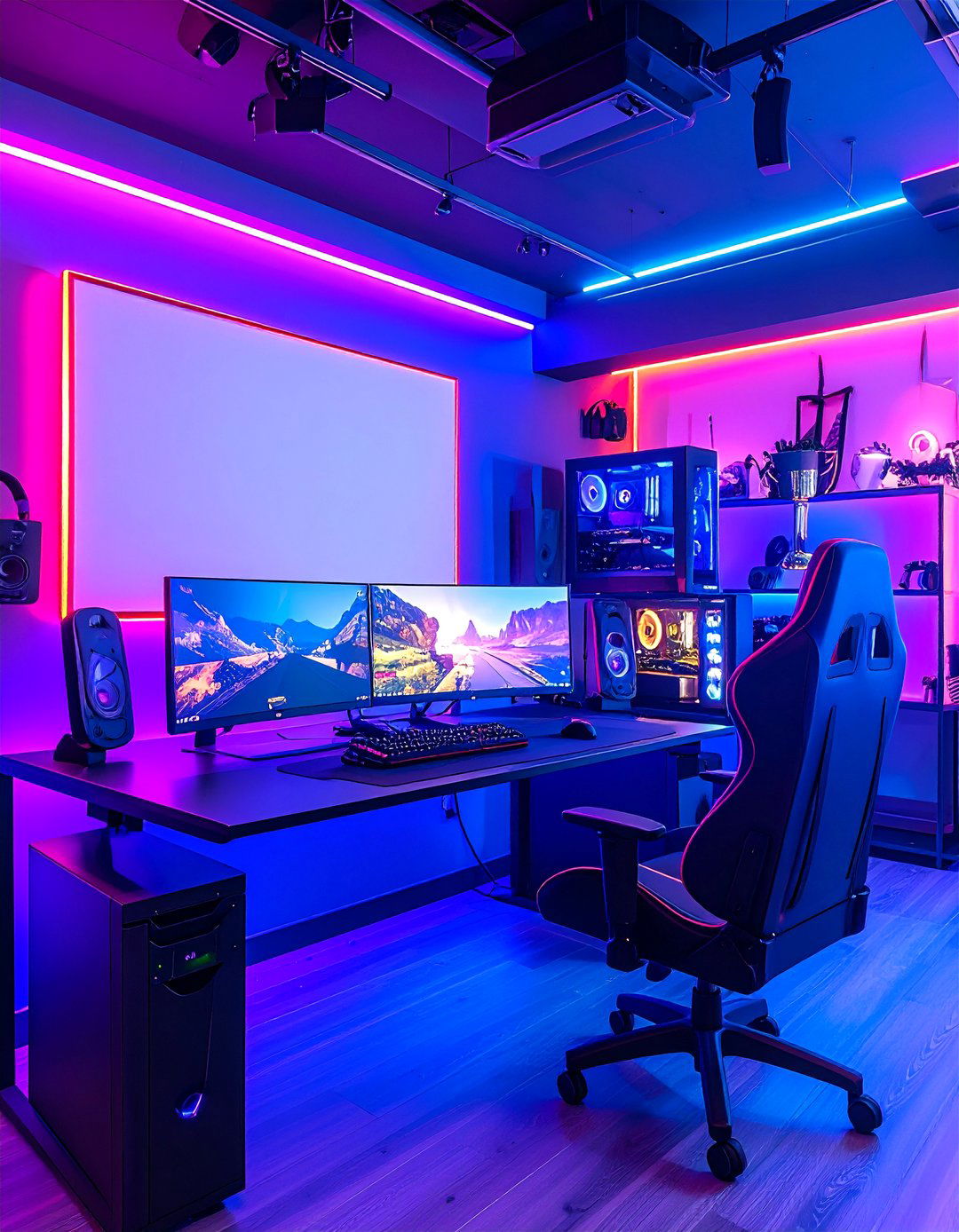
Set one wall as a competitive “stage” with two side-by-side monitors, a wall-mounted whiteboard for tracking brackets, and a ceiling-hung webcam that streams the action. Clip an inexpensive RGB strip around the board’s frame so winning names literally light up, and keep spare controllers in labeled bins beneath the screens for rapid swaps between fighters. If space permits, mount a small trophy shelf overhead to celebrate weekly champions and keep friendly rivalries buzzing.
7. Snack-Bar Arcade Room Refresh Zone
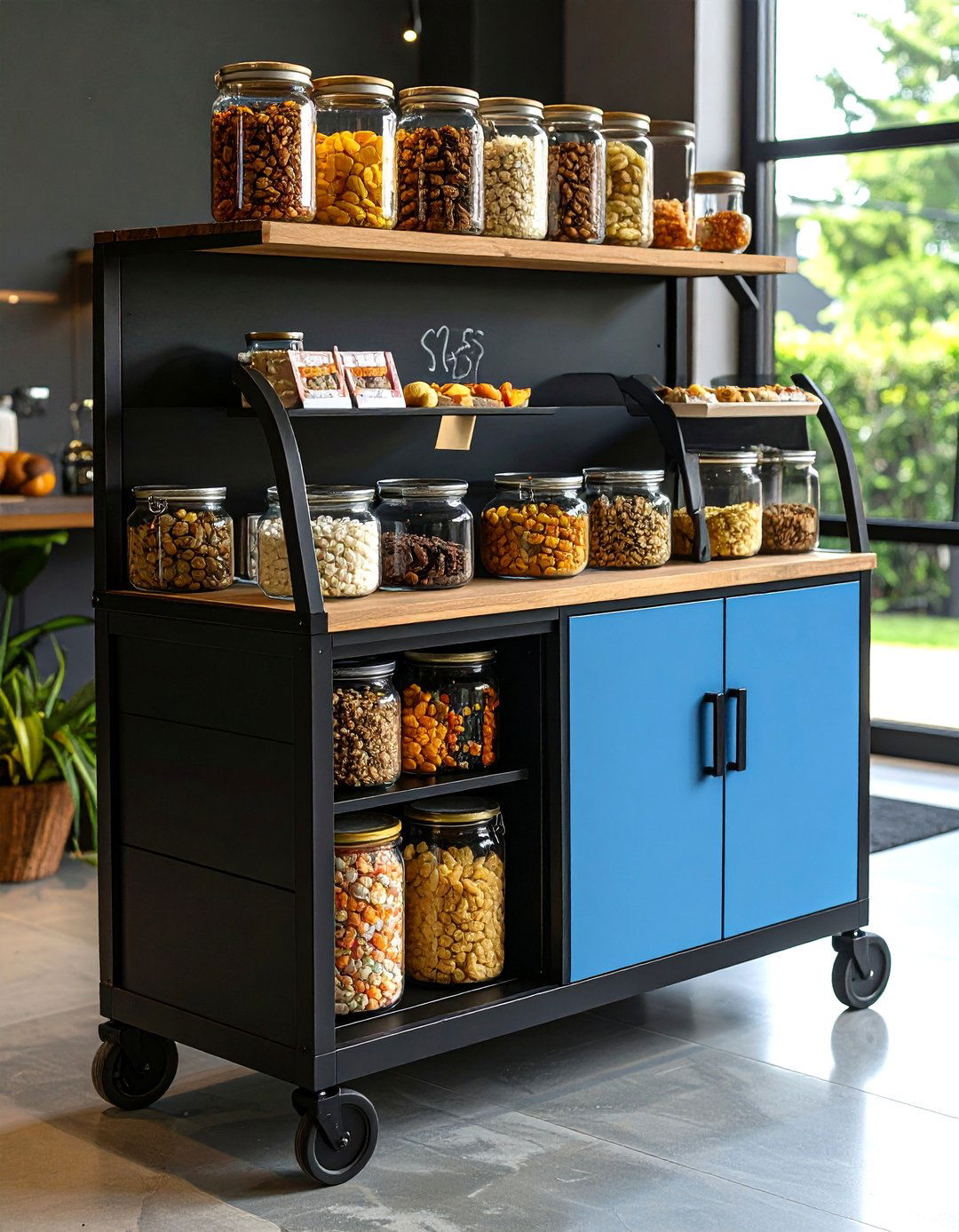
Replace sticky soda cups with a polished, non-alcoholic bar cart: sparkling zero-proof cocktails, canned cold brew, and retro candy neatly jarred. A mini-fridge under the counter holds beverages, while floating shelves display pint-size cereal boxes for Saturday-morning throwback sessions. Chalkboard paint on the backsplash lets guests post their initials beside favorite combos—another subtle nod to high-score tables. Good fuel keeps long play-throughs lively without the mess of full kitchen runs.
8. Multi-Table Arcade Room Playfield
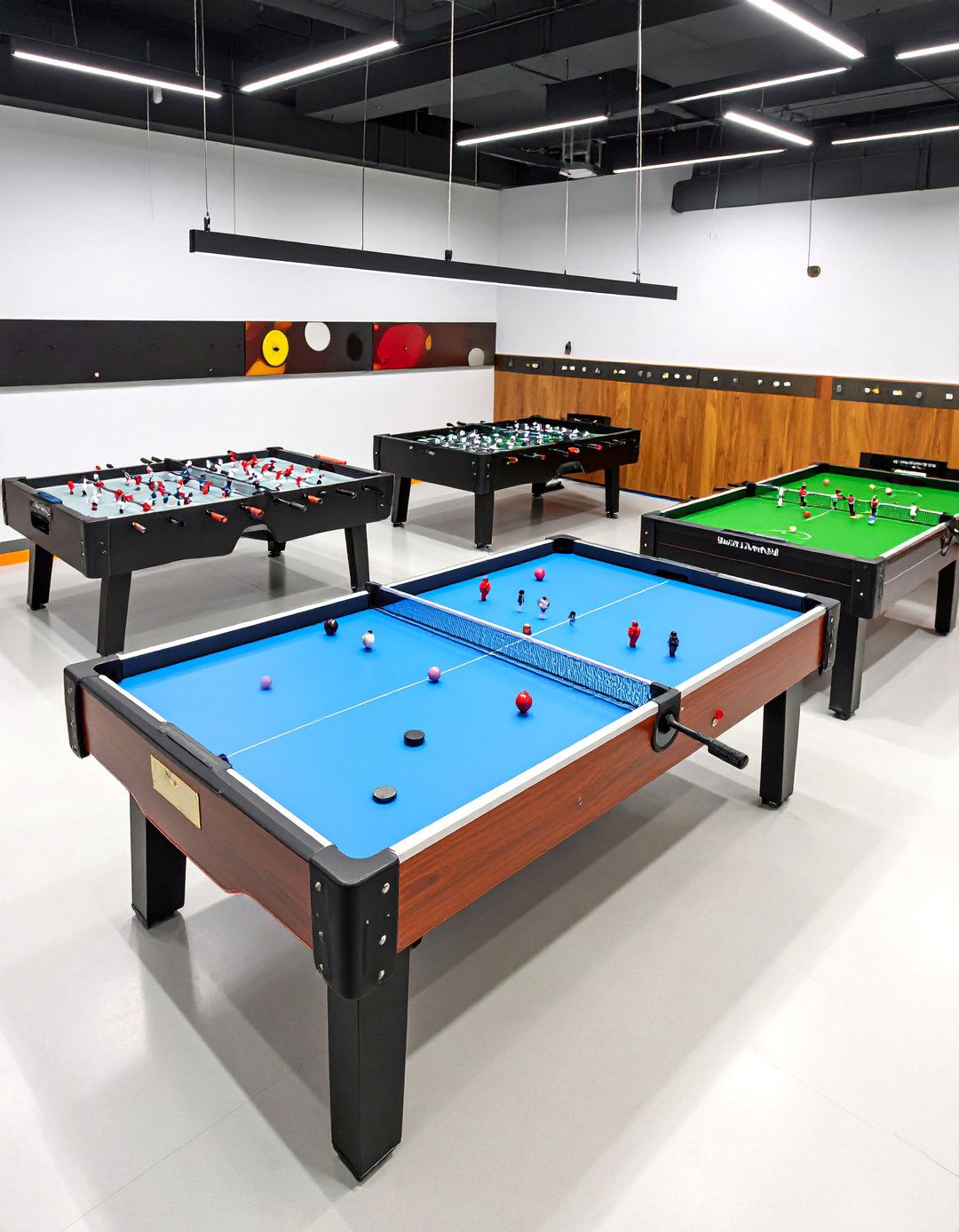
Foosball, ping-pong, and air hockey can coexist if you choose convertible tops or folding legs. Arrange tables parallel with at least three feet of clearance on all sides, and hang low-profile LED pucks over each so balls stay visible without casting harsh glare on nearby screens. Wall-mounted hooks store paddles vertically, saving drawer space and providing a quick equipment check before each match. The spread invites guests who aren’t into digital games to join the fun.
9. Comfort-First Arcade Room Flooring

Interlocking rubber tiles cushion feet during dance-pad marathons and protect dropped controllers. Choose darker hues to hide scuffs, or mix pixelated patterns by alternating colors in 8-bit blocks. The tiles install without adhesive—ideal for renters—and can be lifted to swap pieces that wear out. Bonus: their slight texture improves traction, cutting down on slips when excitement spikes.
10. Graphic-Mural Arcade Room Backdrop

Cover one entire wall with a removable, peel-and-stick mural—8-bit cityscape, neon grid, or manga panel speech bubble—to anchor the room thematically. Because murals act like giant posters, they hide minor drywall seams other décor can’t, and future updates simply peel off without damage. Echo a color or character from the artwork in throw pillows or cabinet side art to unify the space.
11. Console-Cozy Arcade Room Nook
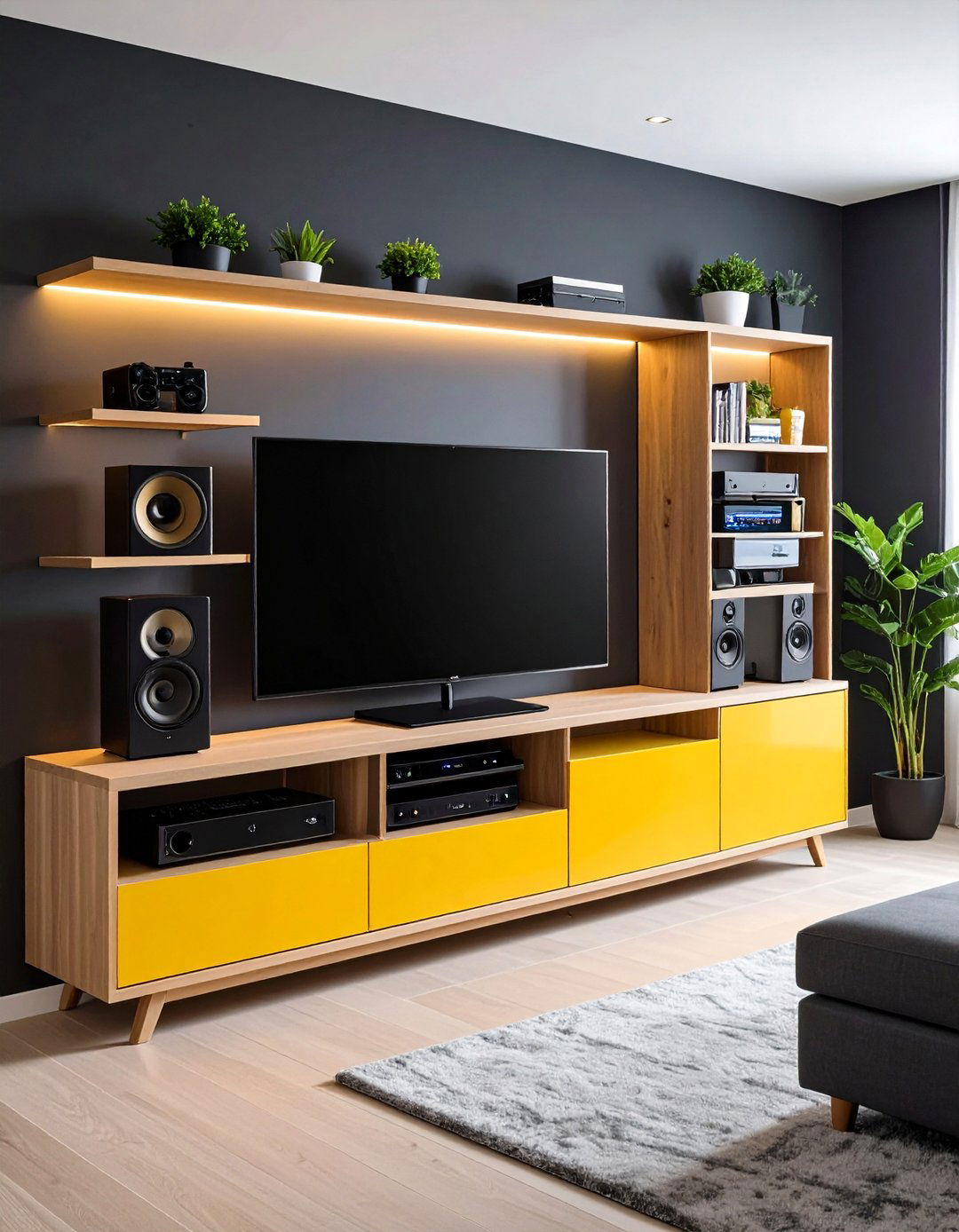
Reserve a corner for modern systems—the PlayStation 5 Slim, Xbox Series S, or Switch 2 handheld dock—so retro and current eras share the same stage. Use a tiered media tower: newest gen at eye level, classics beneath, handheld chargers up top. A slim soundbar below the TV keeps audio crisp without crowding shelves, and labeling each HDMI input avoids frantic input-scrolling when friends swap consoles mid-party.
12. VR-Ready Arcade Room Zone

Clear an eight-by-eight-foot “no-trip” square for headset play, adding soft edge lighting on the floor to signal boundaries. Wall-mount cable reels or a pulldown pulley so headset wires float overhead, and stash a rolling trunk nearby for controllers, silicone face gaskets, and lens cloths. When headsets come off, collapse the trunk into an ottoman and roll it aside, instantly reclaiming floor space for other games.
13. Showcase-Shelf Arcade Room Storage

Glass-front cabinets with LED strips turn cartridge collections and action figures into museum pieces while protecting them from dust. Install adjustable shelves so boxed consoles can stand upright, then hide less photogenic items—power bricks, extra cables—in labeled bins along the bottom. Transparent doors keep younger kids from grabbing fragile pieces yet let them admire the pixel history on display.
14. Cable-Tidy Arcade Room Wiring
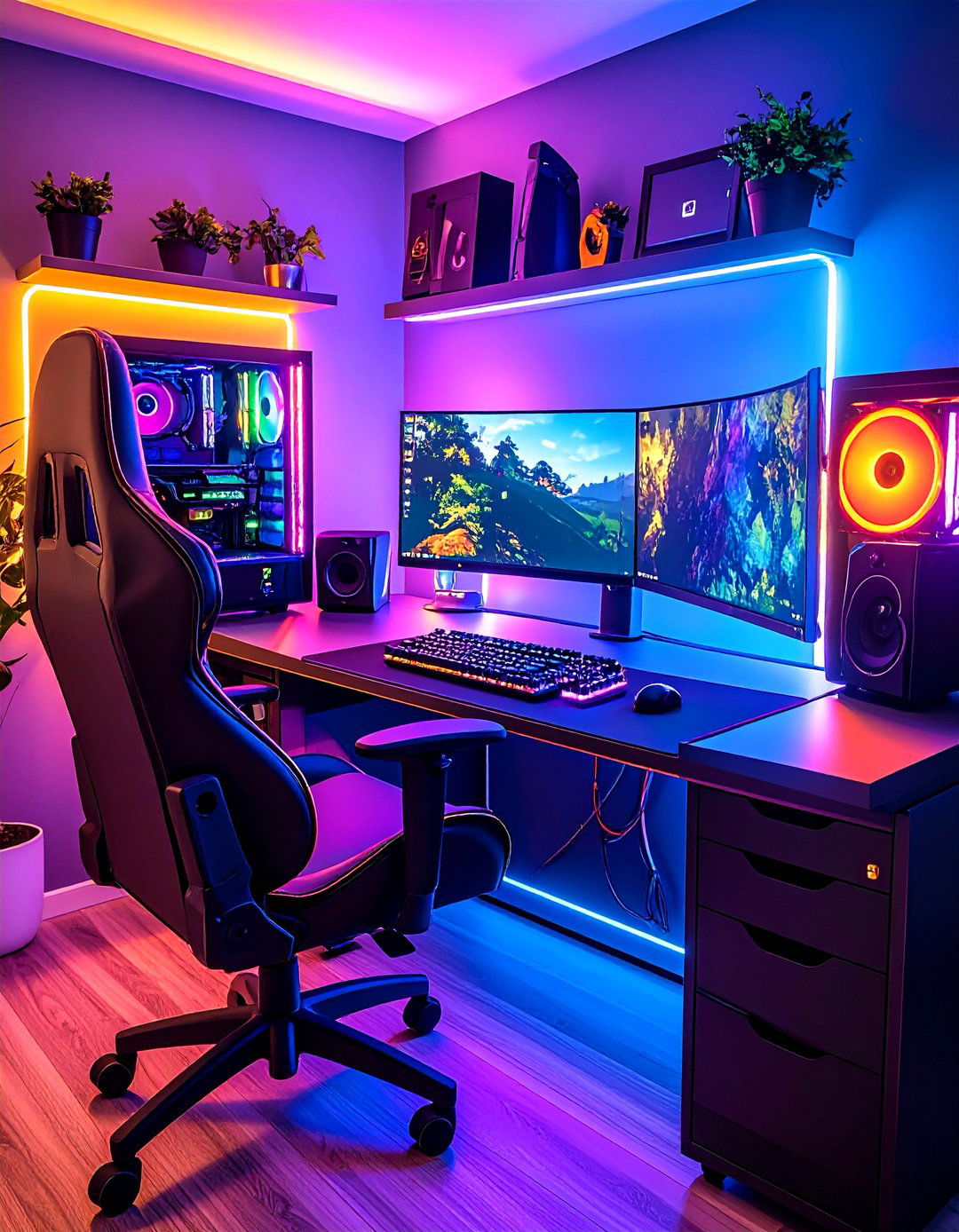
Desks with rear cable troughs and magnetic clamps tame the spaghetti of HDMI, USB, and power bricks. Route console power cords through grommets drilled behind cabinets, and bundle everything into color-coded sleeves (blue for video, red for power) so troubleshooting is painless. With wires off the floor, robot vacuums can roam freely and carpet edges won’t snag controller leads mid-combo.
15. Surround-Sound Arcade Room Audio
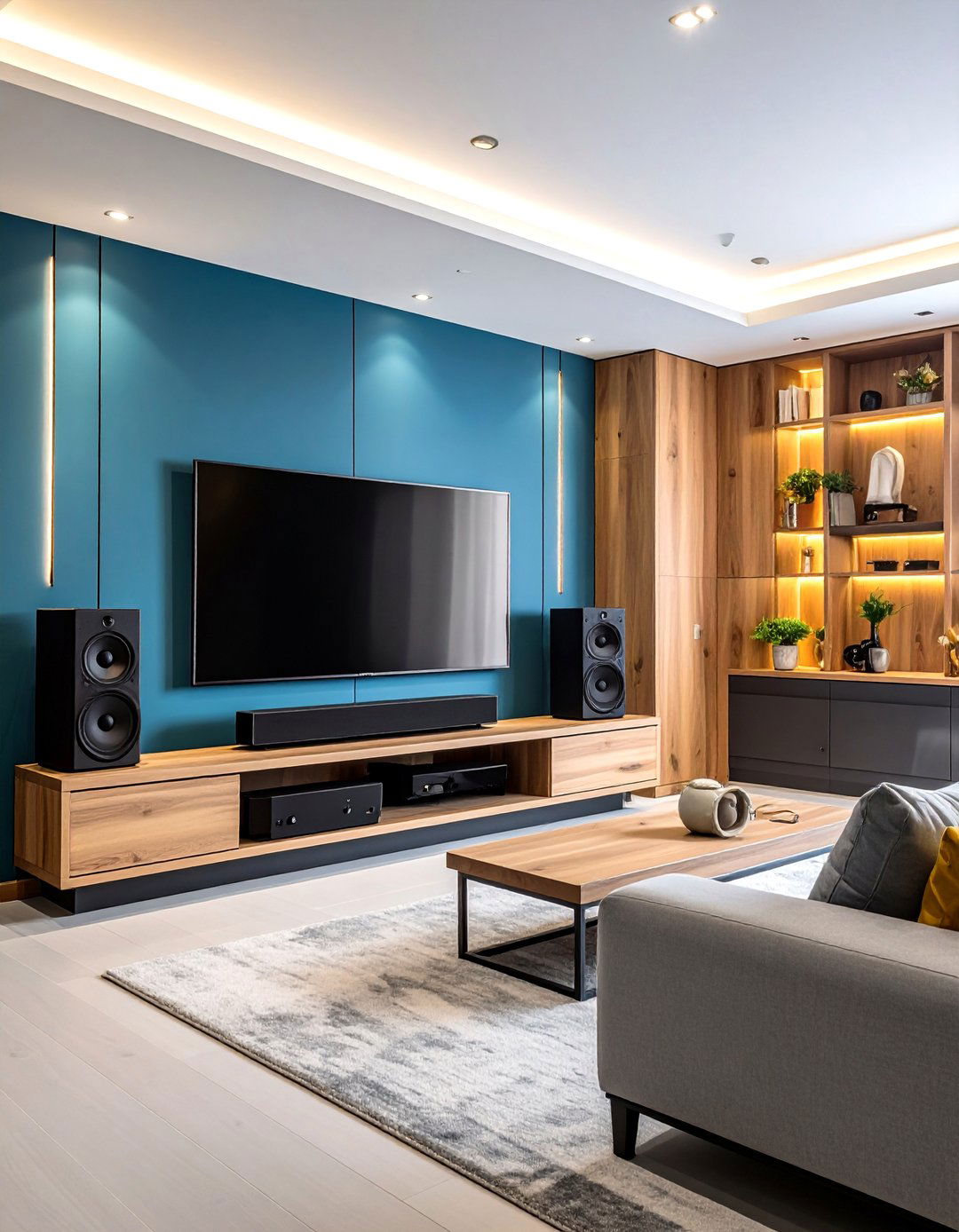
A mid-range Dolby Atmos soundbar like Samsung’s HW-Q800 D fills small rooms with height-channel effects without rear-speaker clutter. Mount it under a wall-hung display and calibrate the bar’s room EQ so cabinet bezels don’t muffle mid-tones. For deeper bass, slide the wireless sub beneath the main cabinet row; rubber tile flooring from idea nine will dampen shake. Crisp, positional sound breathes new life into pixel explosions and chiptune soundtracks alike.
16. Scene-Swap Arcade Room Lighting Presets
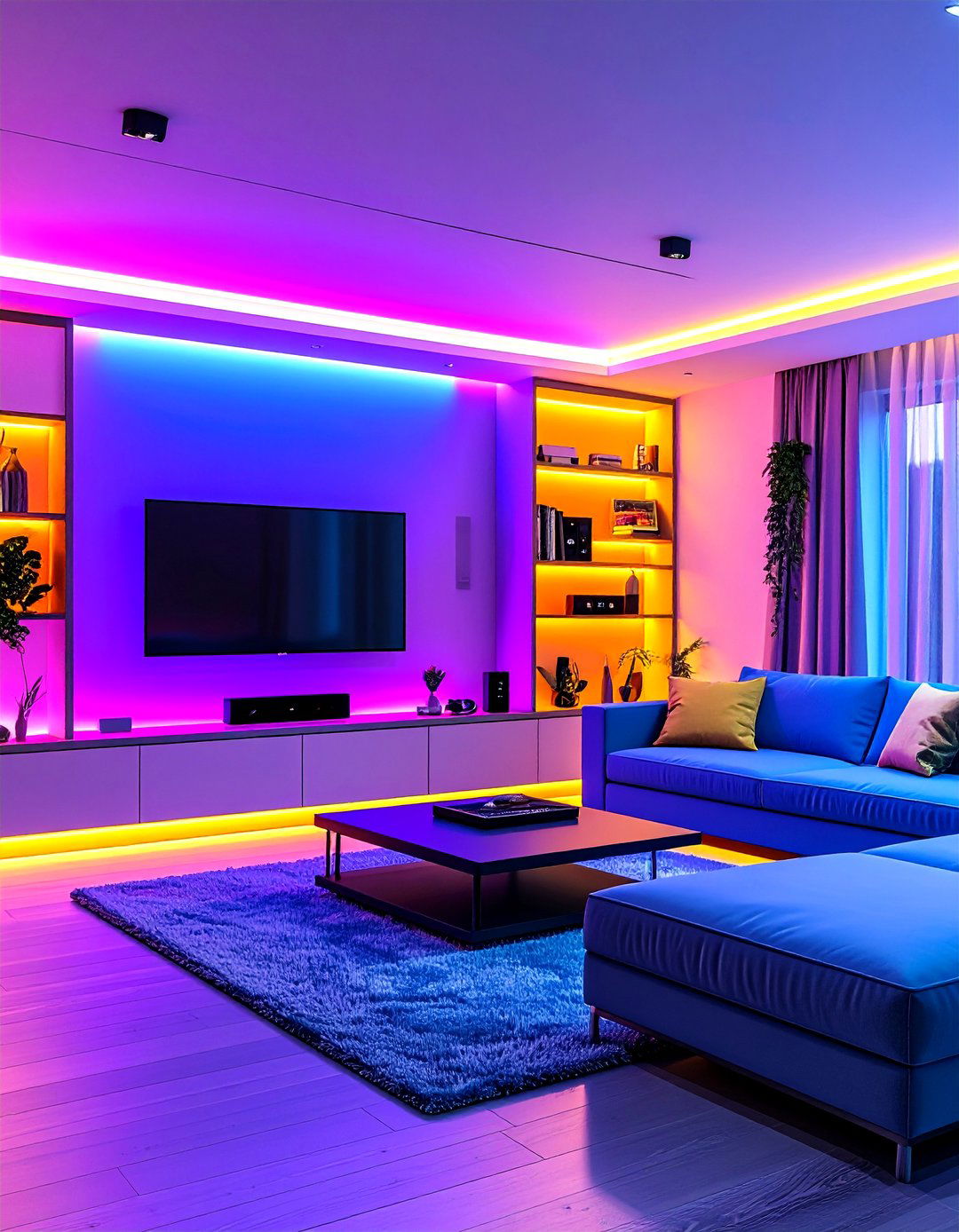
Pair smart bulbs in ceiling cans with your LED strips so one tap triggers a “Retro” preset (magenta + cyan) or a “Movie Night” preset (warm amber). Use a physical wall-mounted button for guests who don’t have the app, and tie presets to voice assistants for hands-free shifts. Automations can fade lights when the TV powers on, adding theatrical flair and cutting electricity when play stops.
17. Basement-Boost Arcade Room Conversion

Concrete walls become an advantage when you insulate them with closed-cell foam and drywall—the perfect blank slate for murals and minimal sound bleed. Combat potential dampness with a dehumidifier on a smart plug, and add low-profile floor vents to keep air fresh during long sessions. Because basements rarely get natural light, mirror-backed shelving and cool-white LEDs prevent the cave effect while keeping glare off screens.
18. Wall-Mounted Arcade Room Consoles
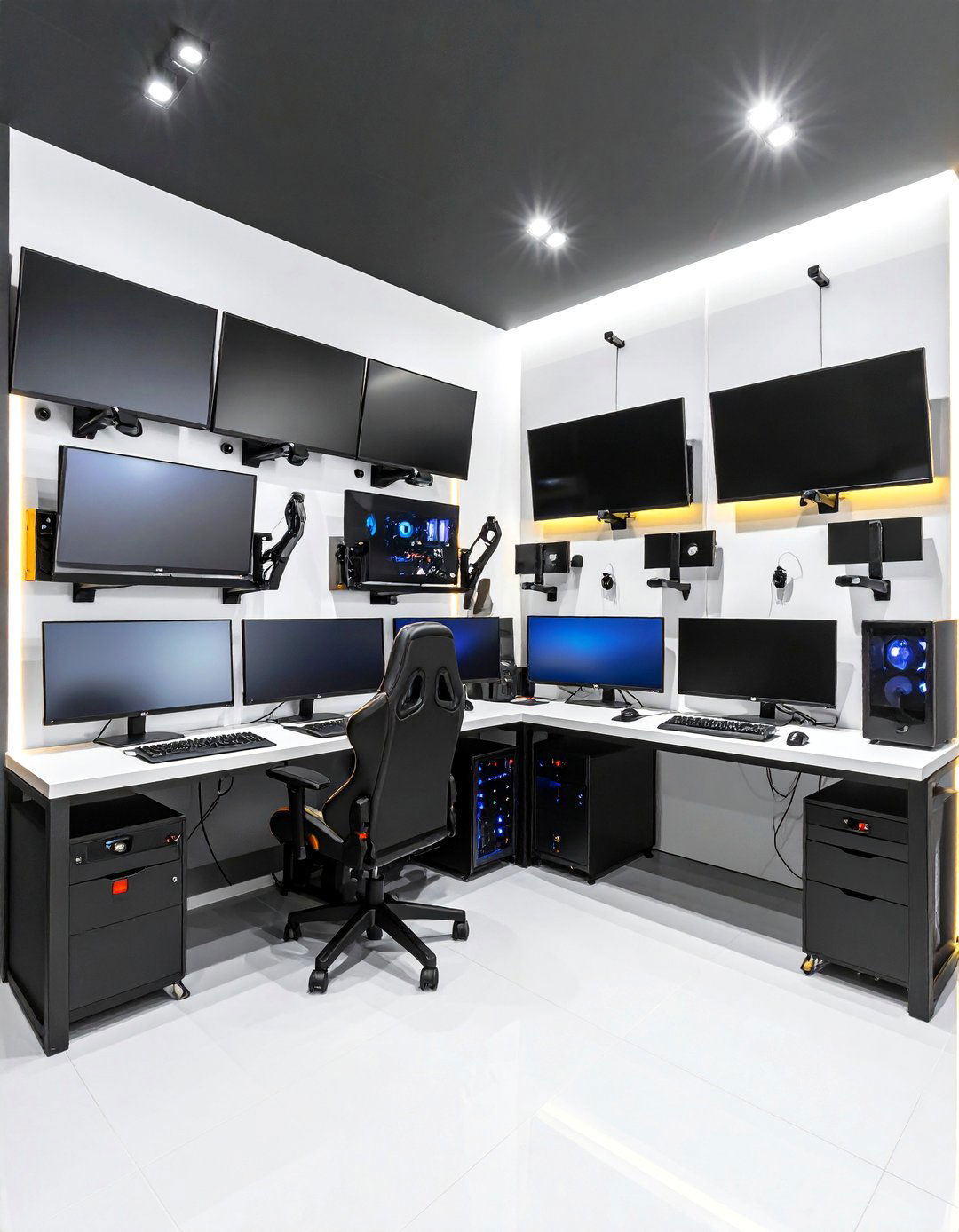
Free up floor real estate by VESA-mounting micro-consoles or mini PCs behind displays and using removable Velcro straps for larger units. Swing-arm brackets let you pivot the console for disc swaps, and labeling each power adapter avoids guesswork. The floating effect cleans the aesthetic, eases vacuuming, and discourages accidental kicks from enthusiastic Dance Dance Revolution moves.
19. Budget-Friendly Arcade Room Upgrades
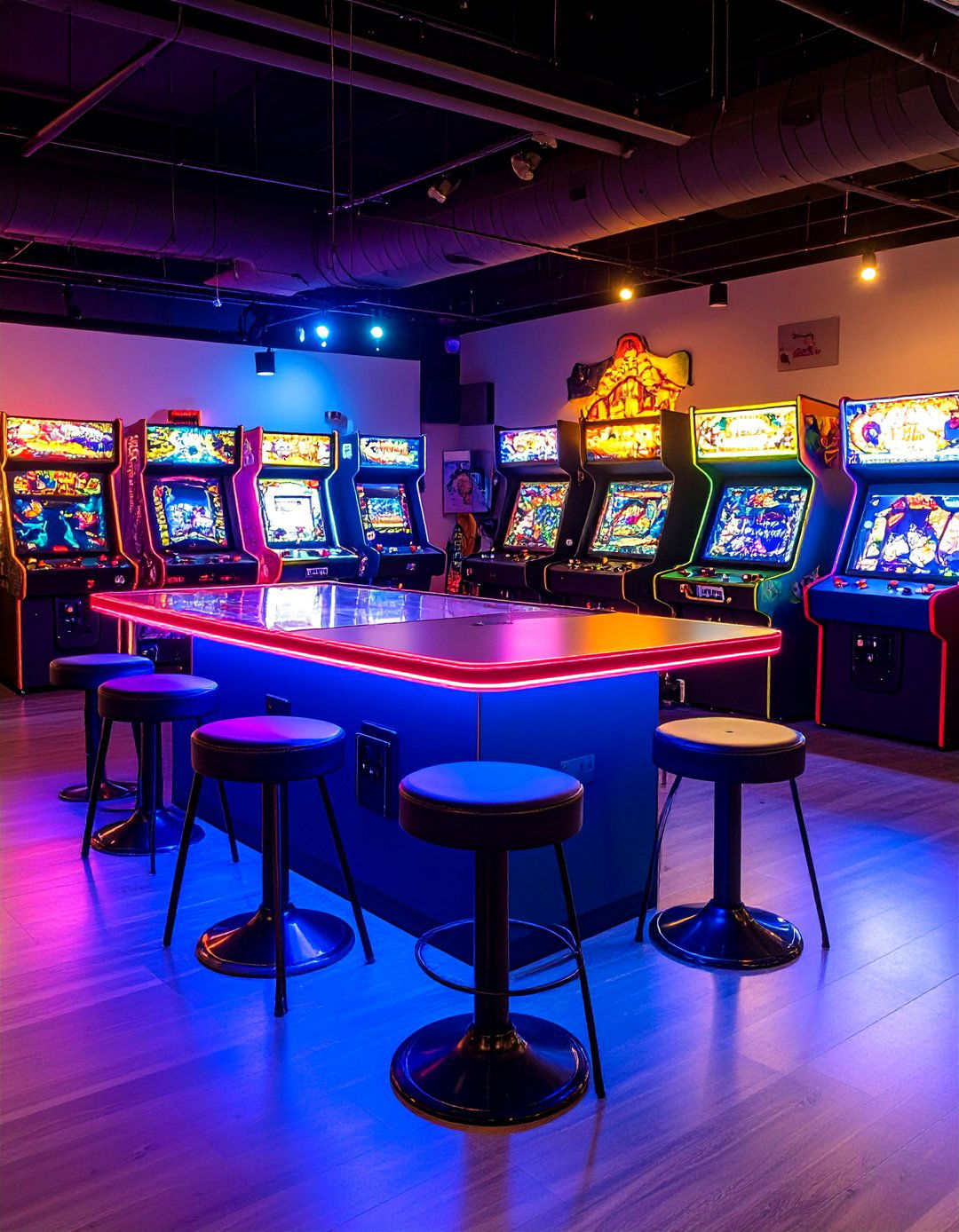
Swapping pricey brand-name bulbs for bargain-yet-feature-rich options like Govee smart lights trims costs without sacrificing flair. Repurpose thrift-store bar stools with new vinyl covers in joystick colors, and print arcade art on adhesive vinyl to refresh aging cabinet sides instead of buying new machines. Redirect savings into high-quality surge protectors—replacement parts cost far more than prevention.
20. Family-Friendly Multi-Gen Arcade Room Flow
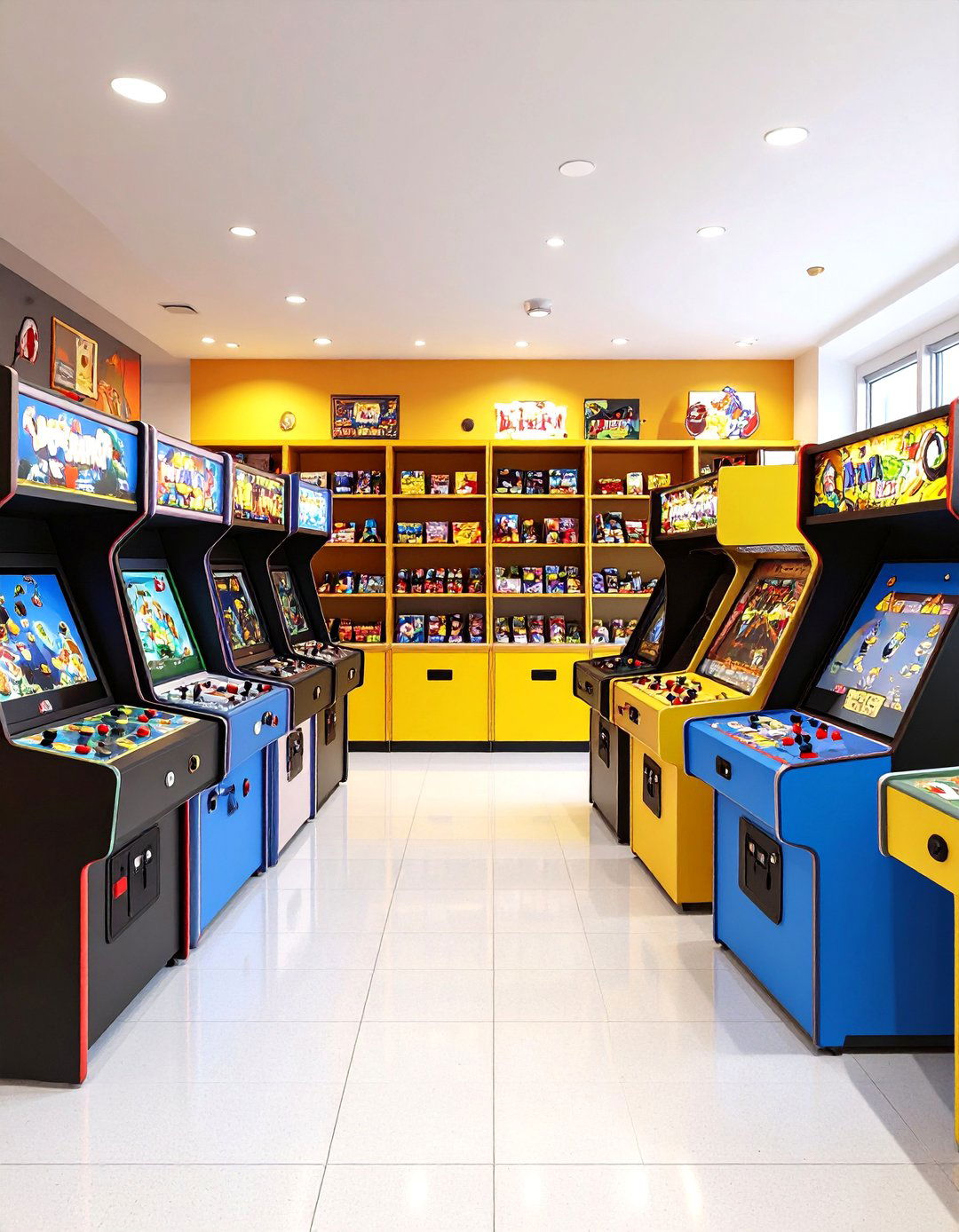
Blend analog and digital by parking a kid-sized pop-a-shot hoop beside the vintage pinball and tucking classic board games under a coffee table. Keep controllers on a central charging dock at child-reachable height, and place a wipeable score journal next to it so even non-gamers can leave doodles or victory tallies. By mixing heights, game styles, and seating, the arcade room becomes an all-ages destination instead of a siloed man cave.
Conclusion:
The best arcade rooms balance sensory thrill, comfort, and smart organization—vibrant lighting that adapts on command, flooring and soundproofing that respect the neighbors, seating and storage that flex with every new obsession, and tech choices that keep budgets sane while leveling-up immersion. Whether you adopt one idea or stack several, these approaches turn any spare room into a high-score haven that welcomes kids, friends, and your own inner gamer long after the credits roll.


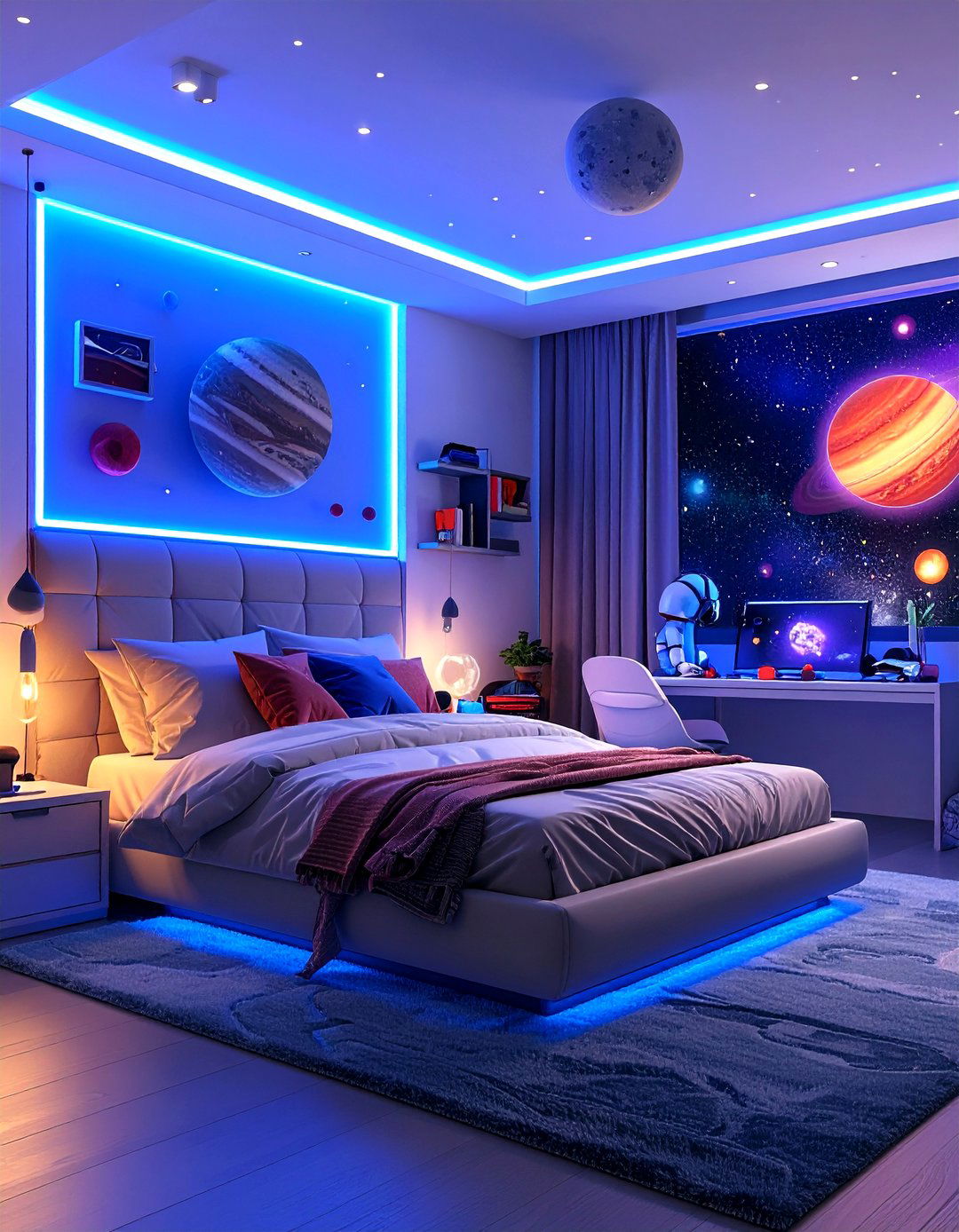
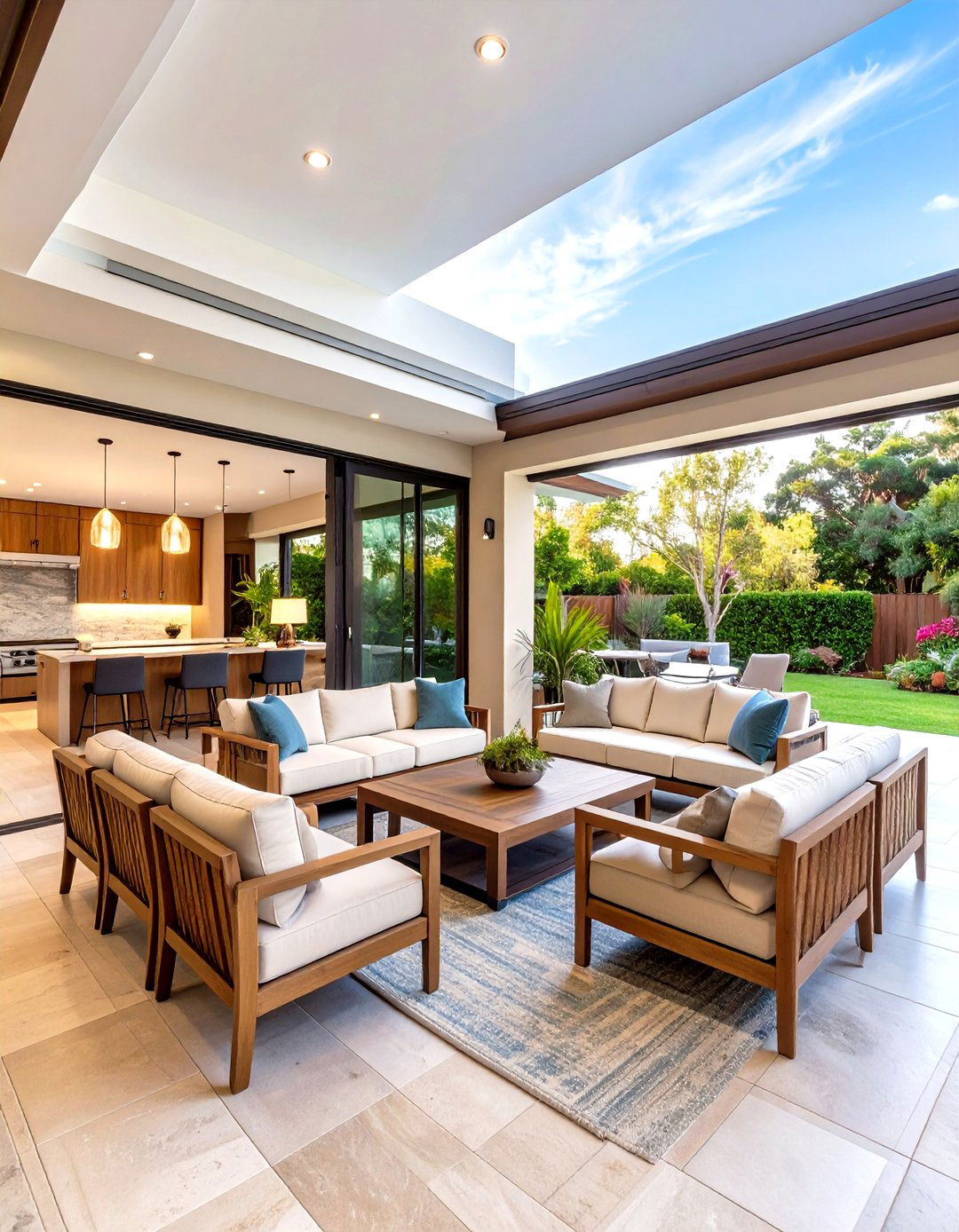
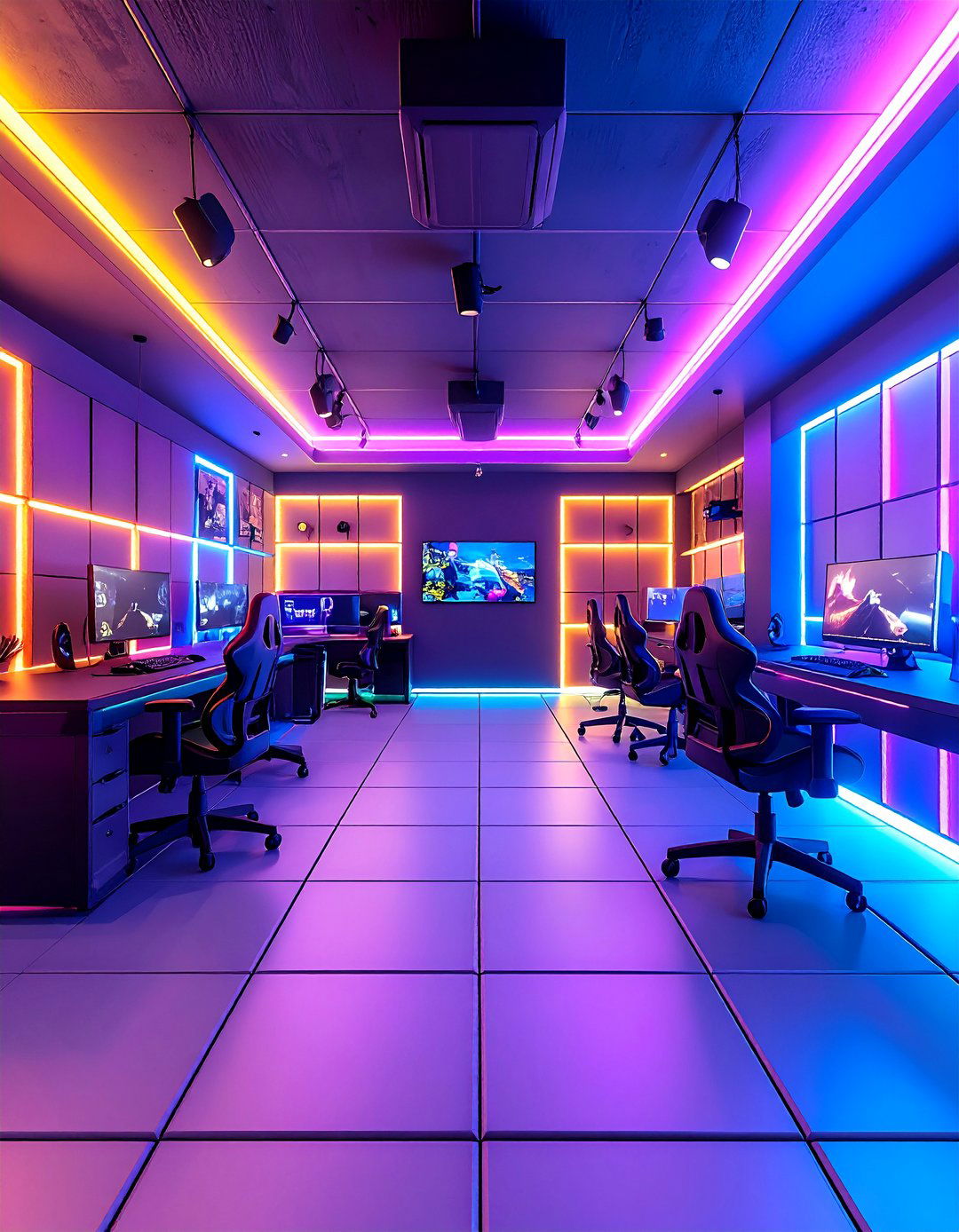
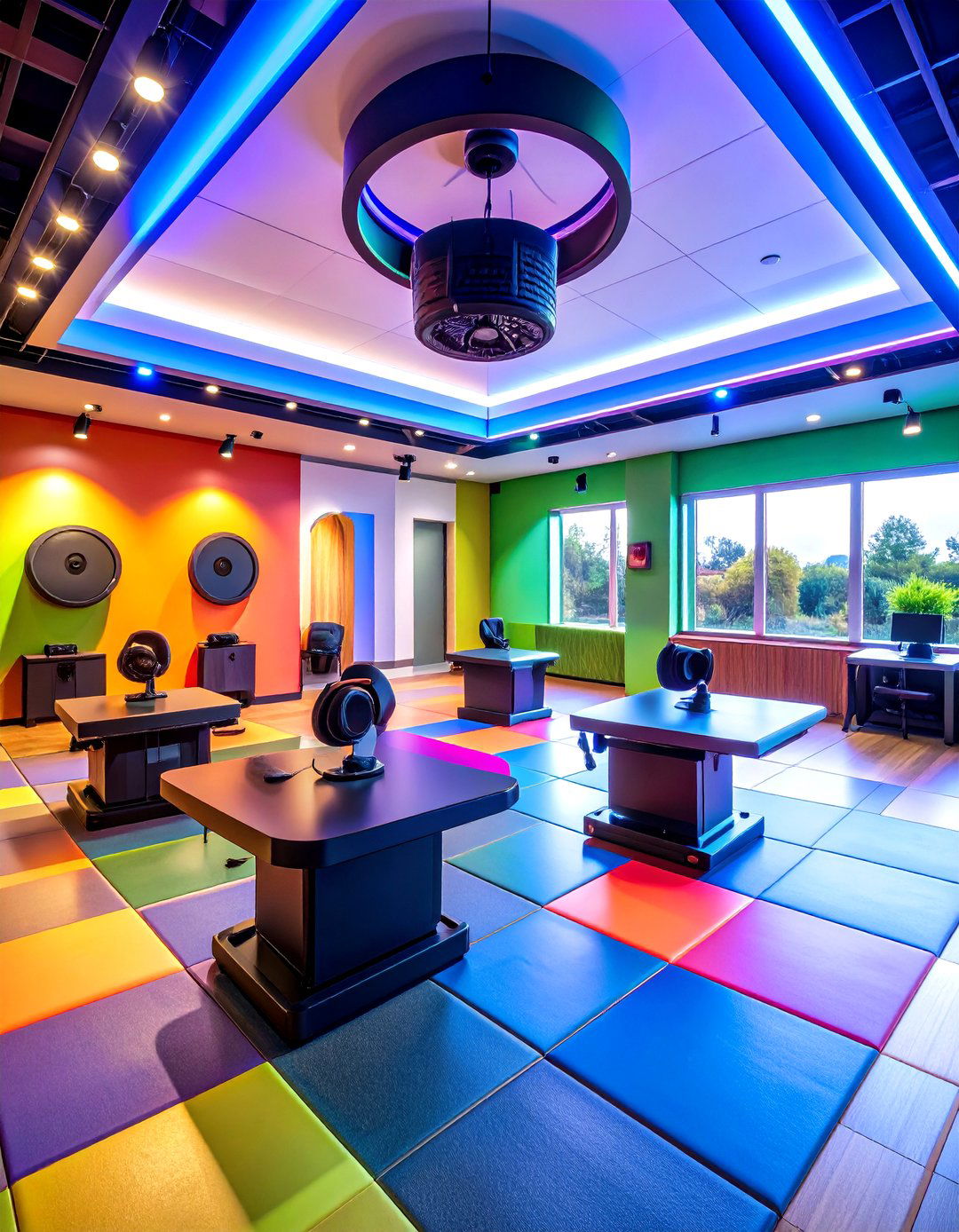
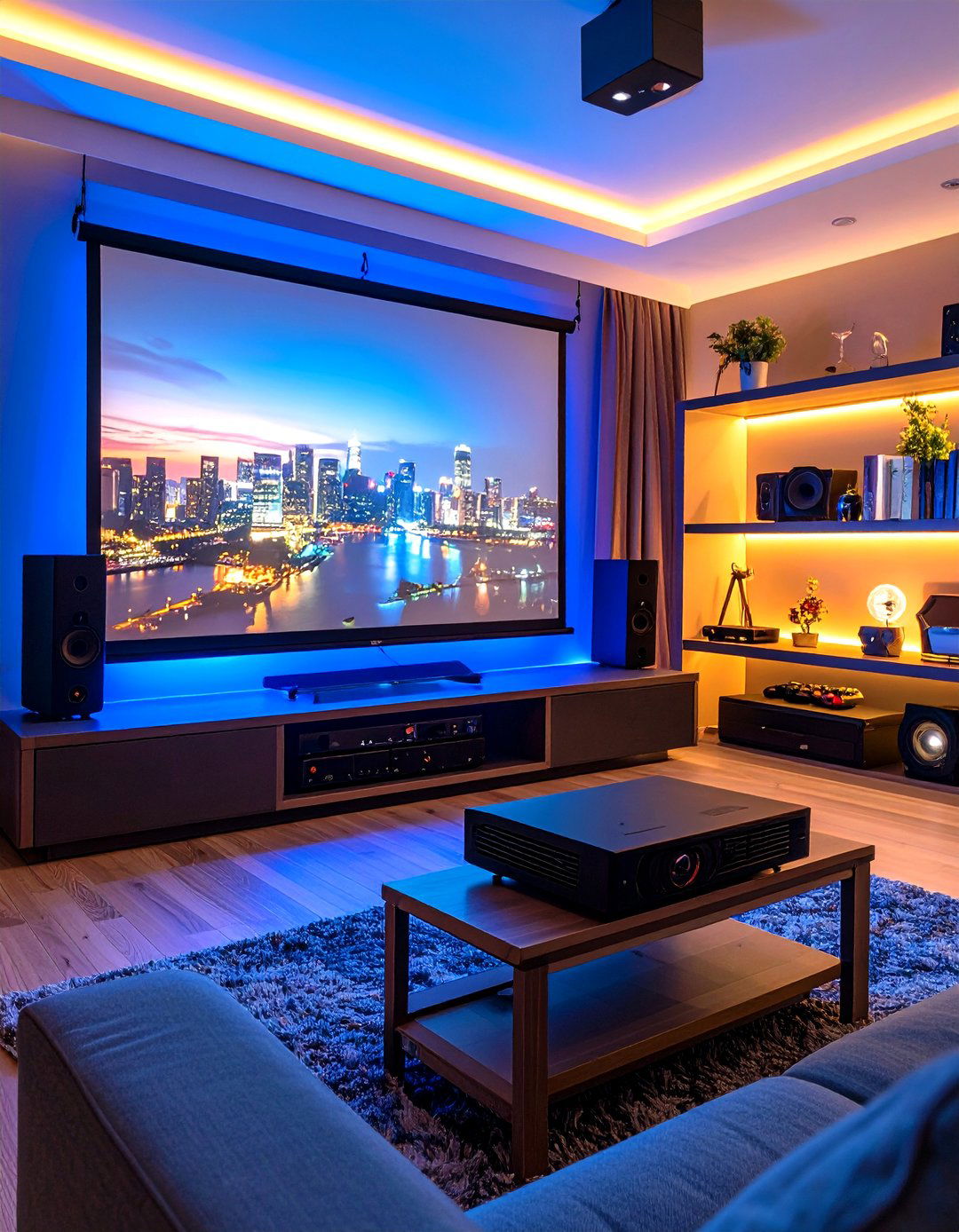

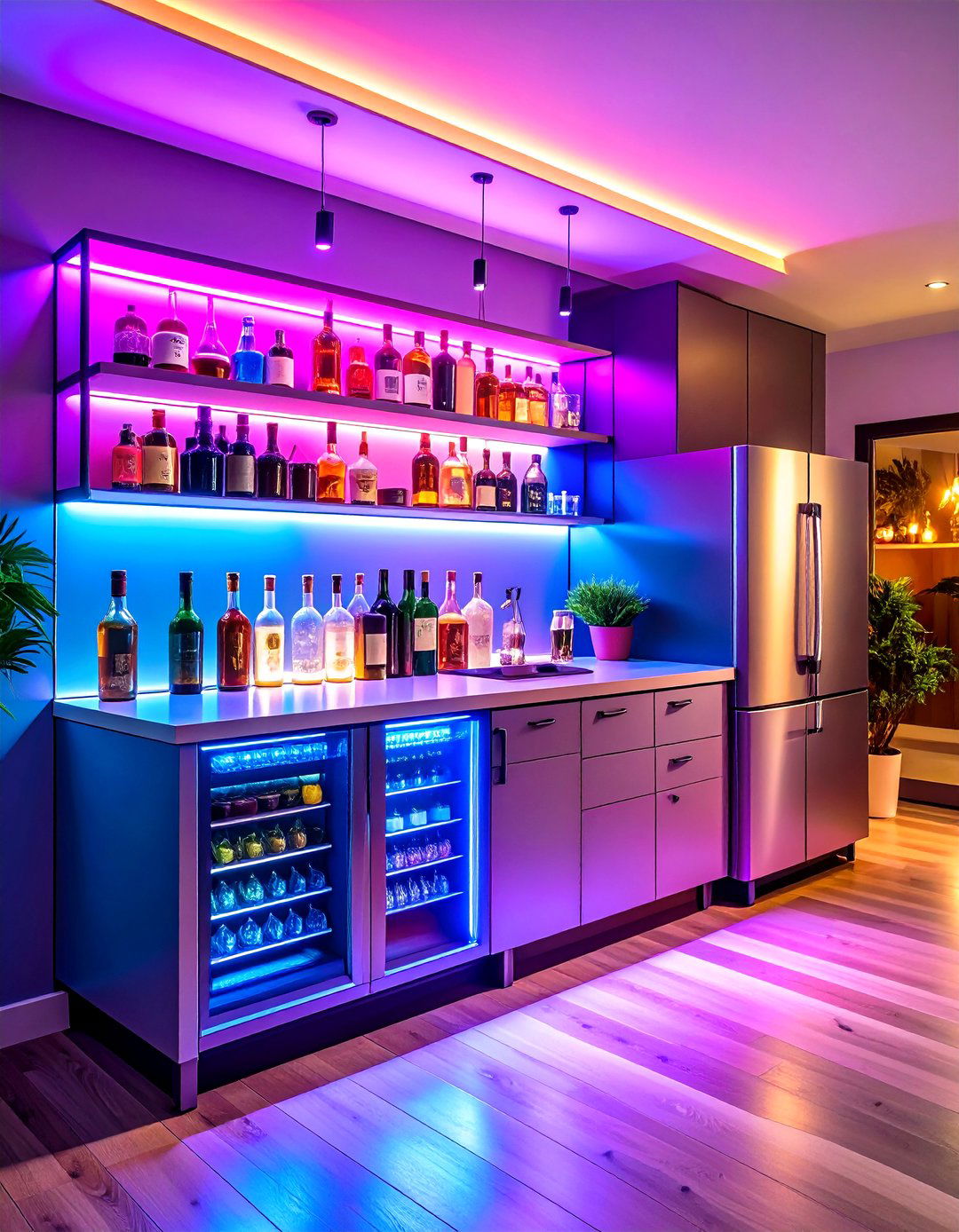


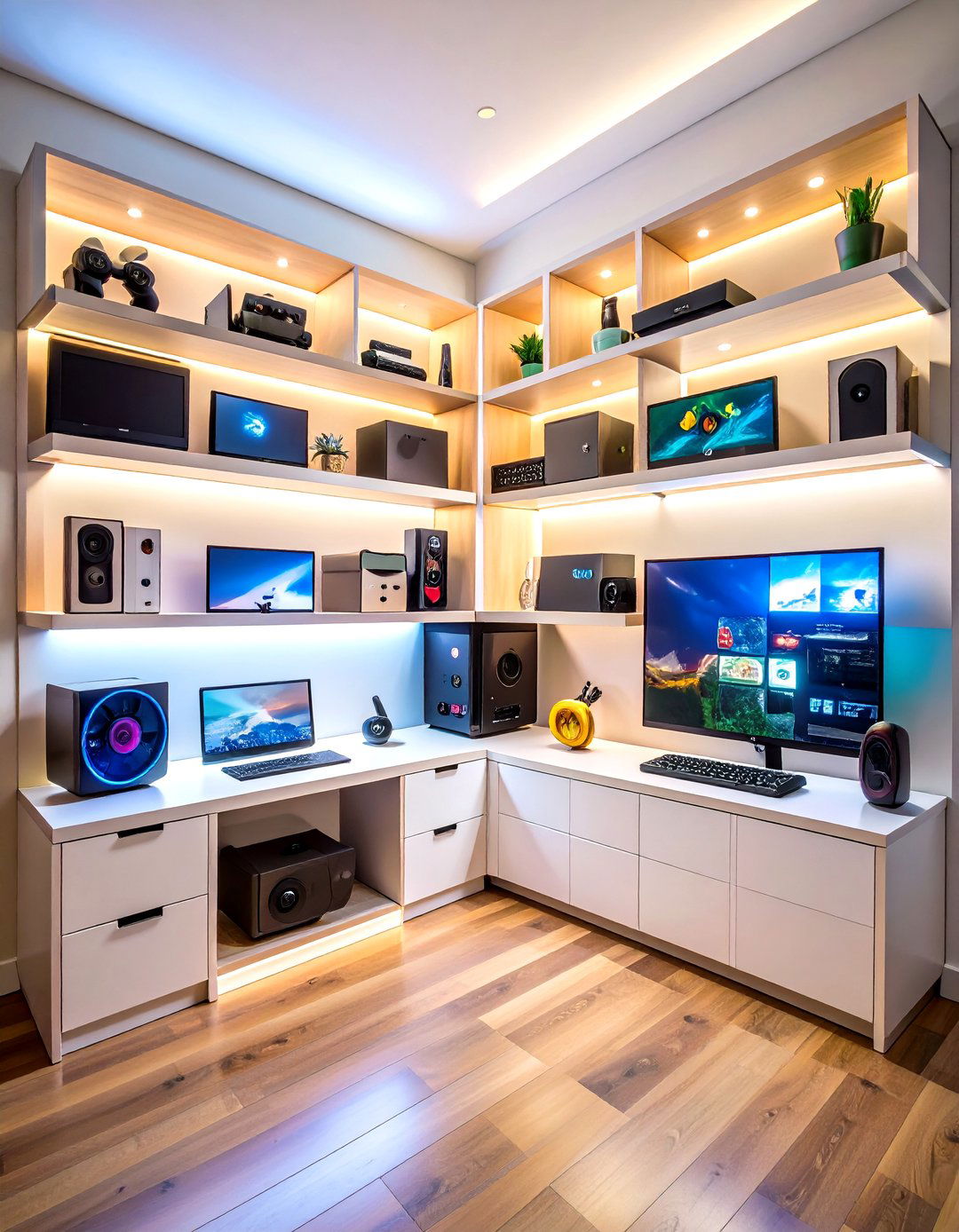
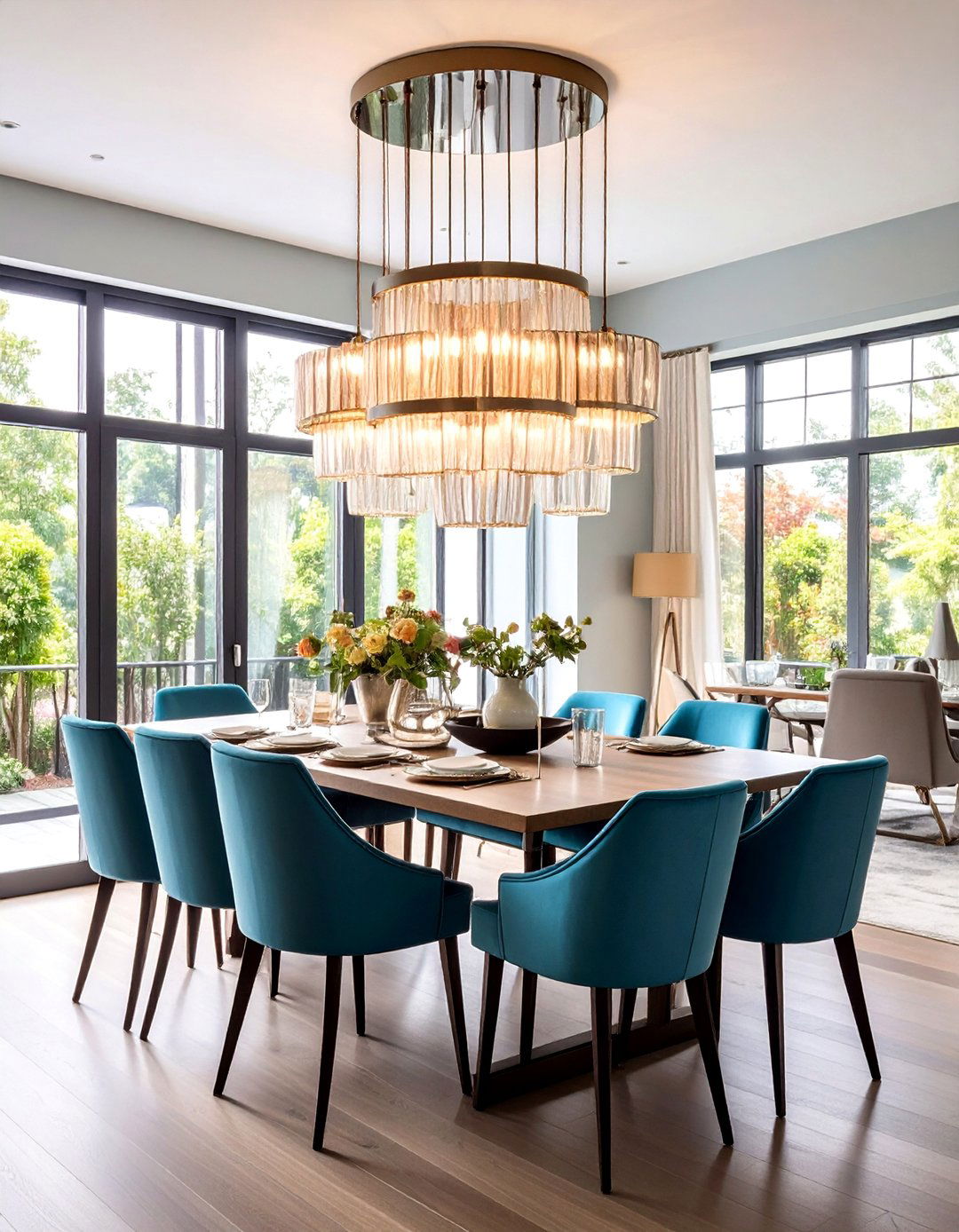
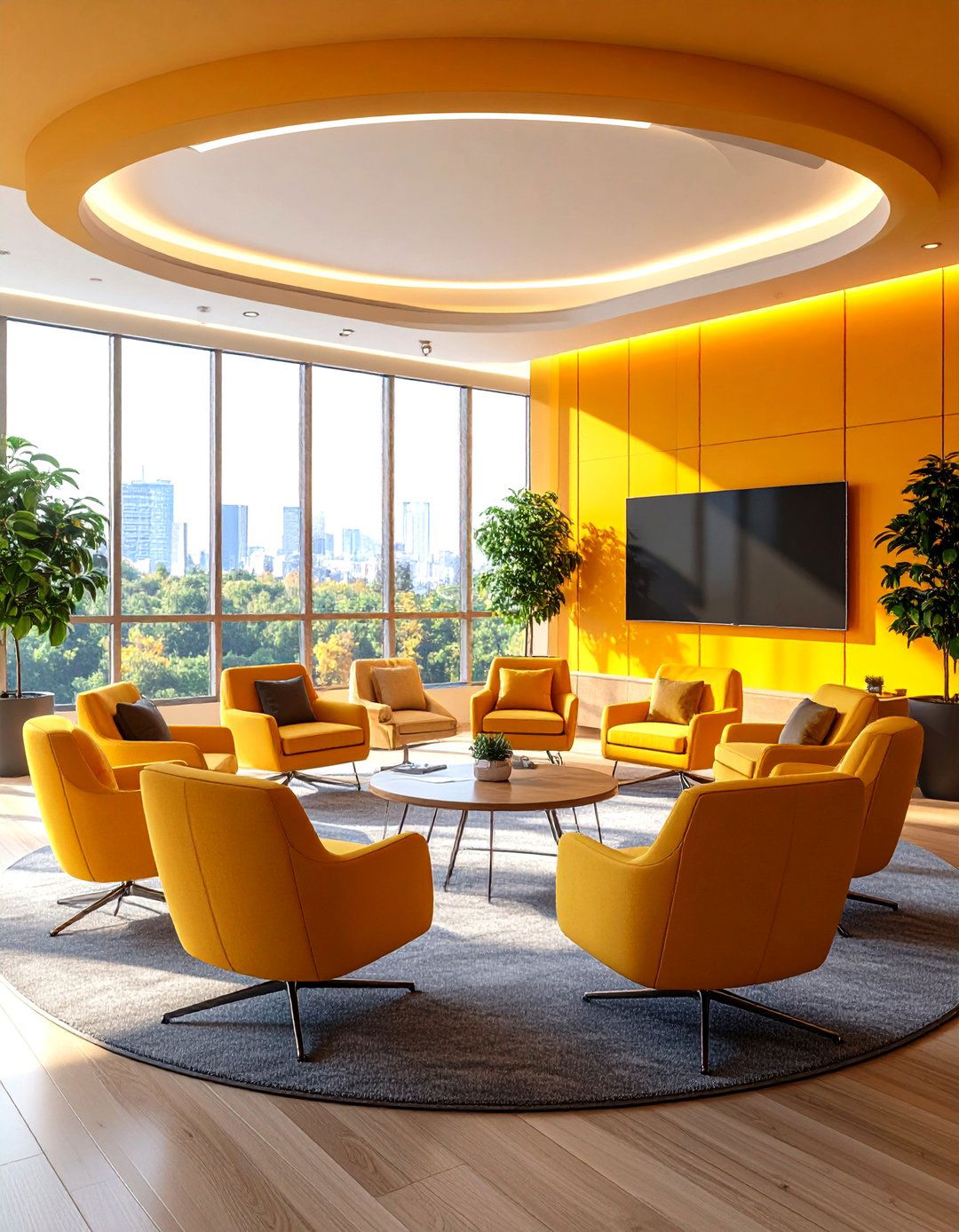
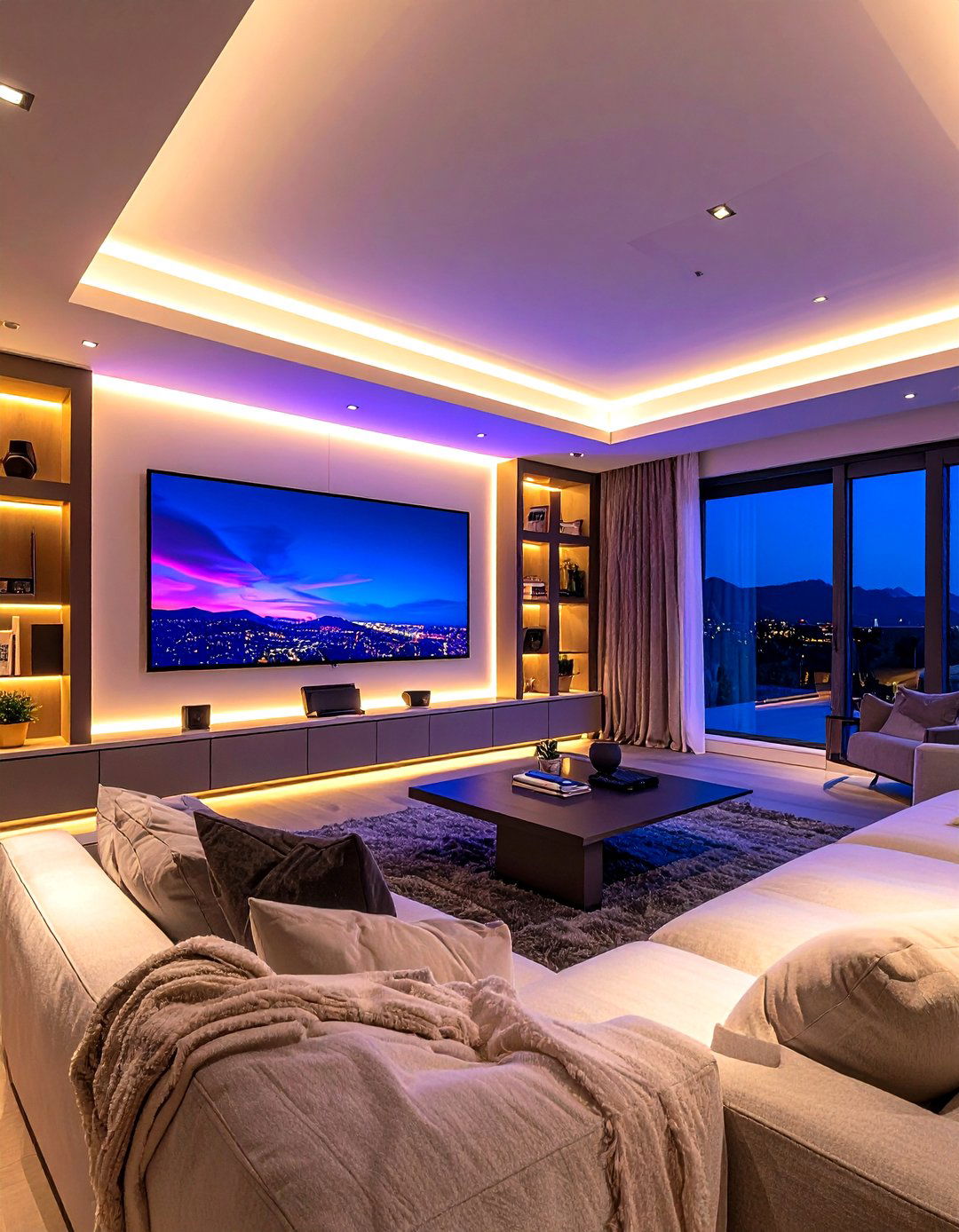
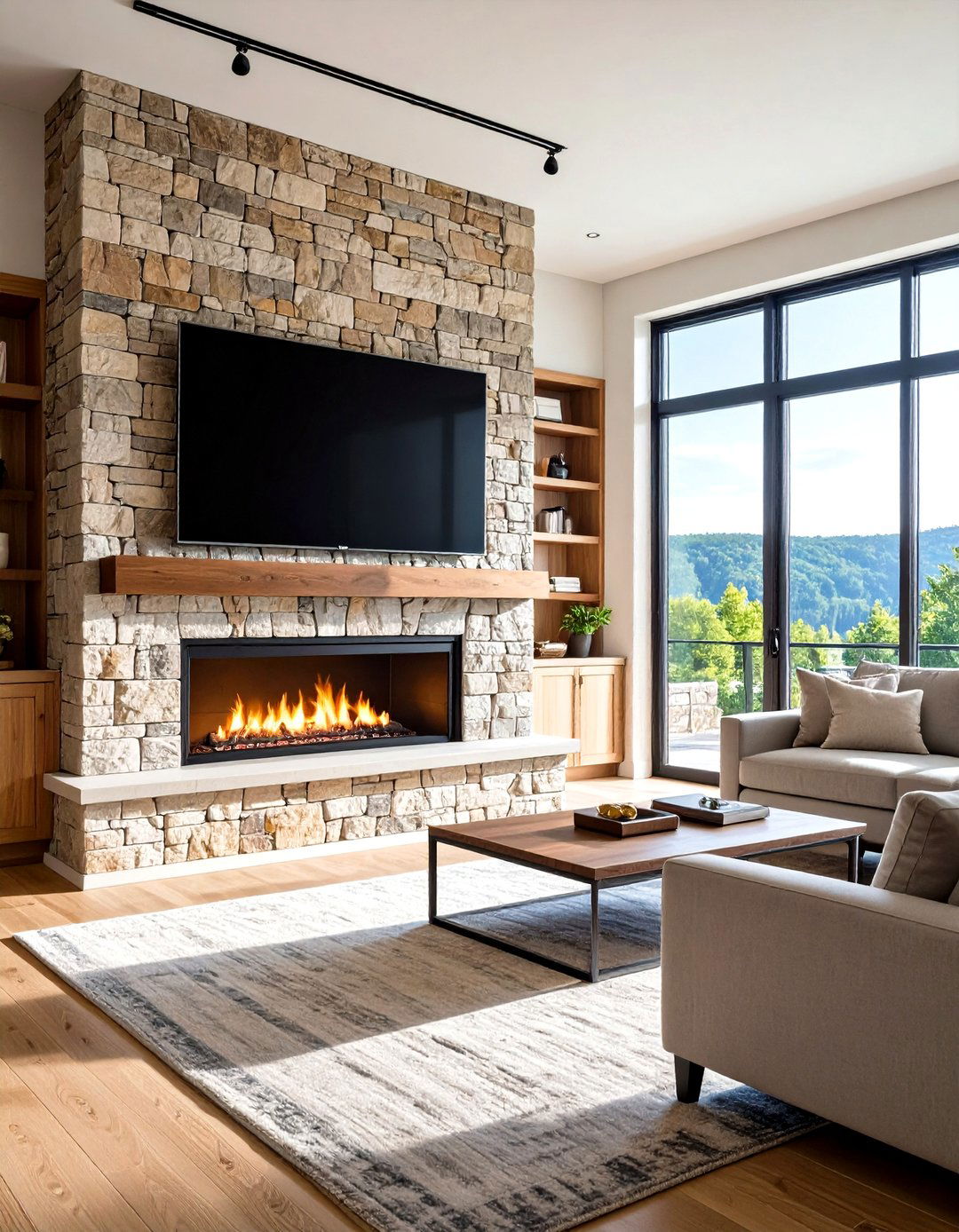
Leave a Reply